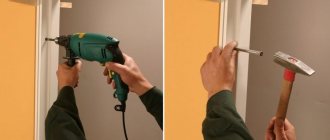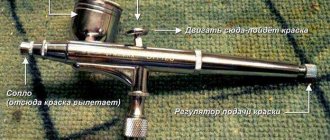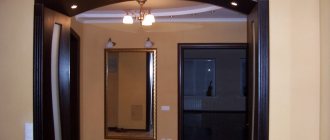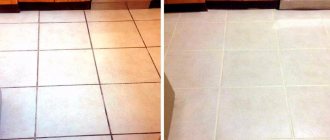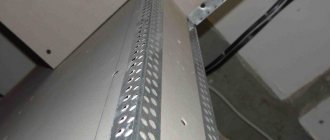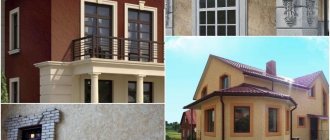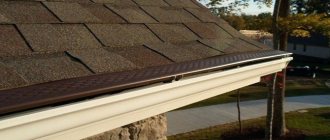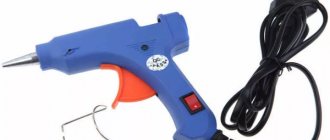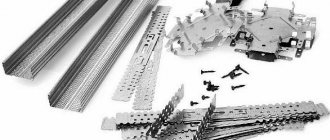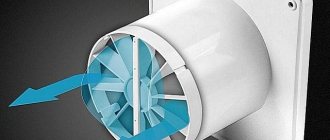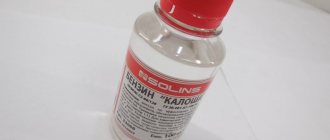If you plan to carry out finishing work, then, first of all, you need to take care of preparing tools for painting work. There are not many types of these tools, however, there are different subtypes and in order to carry out high-quality repairs with your own hands, you need to understand the intricacies. A detailed description of the items required for work will be given below.
What a painter needs: tools and equipment for professionals
The main tool of a painter is a spatula. It is used to apply putty solution to the surface, and it also serves to level the putty. The classification is based on the material used in the production of spatulas: wood, rubber or metal:
- Made of metal, has a steel working part and a wooden handle. It is important that the metal area is smooth and polished; its size can vary from 30 to 100 mm. They are used for cleaning operations (removing old finishes, applying putty to wood, etc.);
- Made from wood, it is used to work with wood putty or plaster layer. Manufacturers can produce from maple, beech, birch;
- Made of rubber, they are intended for closing seam areas, as well as distributing the putty mixture over the surface.
A spatula is used to apply putty solution to the surface; it also serves to level the putty.
The list of accessories also includes brushes. They have wide bristles and a handle; metal staples and glue are used to secure the bristles. Its purpose: applying a primer mixture over large areas and painting walls. In addition, it is convenient to soak the surface with a brush; the process occurs quickly.
Purpose of brushes: applying primer mixture over large areas and painting walls.
These tools are available for sale with metal bristles; they are required to remove the previous outdated layer of finishing to create a rough base.
Required to remove the previous outdated layer of finishing to create a rough base.
Video description
Review of hand and power tools for painting work.
Spatulas
Used for applying putty and smoothing various substrates. Such tools have a wooden or rubberized handle and a flat working surface. Depending on the material they are made of, they come in several varieties.
Metal
Made from steel, the blade (3-10 cm wide) must certainly be smooth and well polished. A wooden handle is attached to its tail section. Such products are used for finishing work: removing old paint, puttying.
Wooden
Solid wood is used as the material for manufacturing. These spatulas are great for working with wood. The blade width is usually 5-20 cm, length – 15-18 mm.
Rubber
The instruments are trapezoidal in shape, with one side slightly thickened. They are often used for sealing joints and leveling putty.
Important! In order for a new spatula to serve for a long time, on the eve of its first use it should be soaked in heated drying oil. After completing finishing work, contaminated tools must be washed and dried. It is also important to ensure that the blade is properly sharp.
The paint spatula is equipped with a flexible blade and is used for removing old paint and varnish coatings, for filling surface defects, and for filling bases. Source mastremont.ru
Differences in tools and equipment for painting work
There is no particular difference between a professional painting tool and one for beginners. Today, everyone can buy a professional tool, but for one-time use, such expenses are usually impractical.
Can be classified as professional - rollers with a long handle and a cuvette for it. As a standard, beginners do not purchase them, but use brushes. Experts value them for the convenience and speed of application.
This also includes a spray gun and a spray gun. The latter can be electric, and it is most often purchased by painters; the cost is high.
There is no particular difference between a professional painting tool and one for beginners.
Rubber spatula
This is a rather rare type of instrument that is not very popular. The main difference from analogues of other materials is that such spatulas do not have a handle. This greatly reduces the usability of this tool.
In the place where the handle usually stands, there is a thickened part of the tool in the form of a trapezoid. Rubber spatulas do not have as much functionality and are mainly used for filling seams and removing marks and small cracks.
Painting tools
Painting products can be divided according to the method of application, so manual and mechanical ones are distinguished. Mechanical, as mentioned earlier, is usually chosen by professionals in order to carry out a high-quality finish. To cosmetically transform a room, it is permissible to limit yourself to the use of manual means:
- Tassels;
- Spatulas;
- Rollers;
- Additional accessories.
To cosmetically transform a room, it is permissible to limit yourself to the use of manual products.
Types of paint brushes
Brushes are a common tool for applying a variety of finishing solutions, as well as paint. They are chosen by both professionals and beginners. Different brush options can be used to achieve varied results.
Manufacturers have come up with many types of this equipment to simplify repair work. Thus, there are the following types of brushes: fly brushes, radiator brushes, handbrake brushes, tassel brushes, paneled brushes, fluted brushes, trim brushes.
Different brush options can be used to achieve varied results.
Rollers
They are not represented in such a wide variety as tassels. They can reduce the period of painting or applying paint solutions. There are the following types:
- Made of fur, intended for surface treatment with paint and only paint. Experts advise soaking it in water before use;
Designed for surface treatment with paint and only paint. - Made from foam rubber, it creates an even and smooth coating, and it is better to use it on such surfaces. It is not allowed to work with paint and varnish products containing thinner.
Creates an even and smooth coating, and is best used on similar surfaces.
Wallpaper scraper
This is a convenient, useful, practical device. Using it, you can lift the edge to carefully cut off the excess part or glue the peeling layer. It allows you to do without painting knives, scissors, and other sharp objects. Safe for your hands.
Wallpaper folding tool
A special plastic was used to make the scraper. Its surface is smooth (does not damage the wallpaper and prevents even thin layers from tearing). The dimensions of the scraper are selected so that it fits in the palm of your hand and provides room for work. Suitable for bending wallpaper in hard-to-reach places (inner corners, at joints).
| Price | 140.93 rub. |
| Rating | 5.0 |
| Reviews | 4 |
| Orders | 6 |
| Delivery to Russia | 49.67 rub. |
Buy on Aliexpress
Spray guns and spray guns
An atomizer can be described as a container with a spray. The action of distributing the paint occurs due to the repulsion of particles from the sprayer by air, thus the solution is applied very quickly. The tool allows you to obtain high-quality painting, the paint material is distributed evenly on the surface, and the paint itself is also saved.
The tool allows you to get high-quality coloring.
There are manual and electric spray guns. The first type is simpler in design, the efficiency of the second is higher. They are suitable for working with adhesive and lime paints. For thicker types of solutions, it is necessary to choose paint spray guns.
It is suitable for working with adhesive and lime paints.
Stick for neat grouting of tile joints
During grouting, many difficulties arise. The solution often overflows, staining the surface of the ceramic tile. Using this stick, you can carefully rub the seams, completely covering them with the solution. Its thoughtful design leaves no voids between the tiles, providing high-quality, reliable, durable adhesion.
Set of ball tile grout
The stick allows you to make a shallow groove along the entire length of the seam. As a result, the solution does not rise above the tiles, it turns out recessed, neat, without excess or smudges. The stick is made of durable materials and is comfortable to use.
| Price | RUB 596.60 |
| Rating | 4,9 |
| Reviews | 110 |
| Orders | 205 |
| Delivery to Russia | Free |
Buy on Aliexpress
A set of additional equipment
In addition to tools for applying solutions, the painter also needs other equipment to make the work faster and more efficient. The set includes the following items:
- Containers for preparing solutions;
- A drill or hammer drill to mix the components for mixtures, or a construction mixer;
- Sponges, rags;
- Stencils for creating patterns;
- A stepladder for working with tall objects, or an extension rod.
In addition to tools for applying solutions, the painter also needs other equipment to make the work faster and more efficient.
Professional painter's tool and its use
In addition, to treat walls or other areas with liquid compounds, painters need rollers; they help out painters when it comes to working with a larger area. They can be from 10 to 25 centimeters in length. 4-7 centimeters in diameter. Can be used for applying primer.
They are also divided by material into fur and foam. There are also rollers on sale for covering staircases and other long but narrow structures with the product. They are a handle with two rollers.
To work with a roller, you should prepare a special cuvette in which it will be convenient to roll them in the product.
To work with the roller, you should prepare a special cuvette.
Laser rangefinder
This handy tool helps you measure the length, width, height of a room without moving. It is enough to lean it against the wall and get accurate results in the desired size.
Laser measuring device Lomvum
The laser rangefinder is highly accurate. The measuring mechanism is configured to ignore errors, providing reliable results. This tool will be useful for professional architects to create a measurement plan, as well as for painters and plasterers. It allows you to quickly calculate the wall surface, determine the consumption and costs of purchasing finishing materials.
| Price | RUB 1,073.07 2,444.76 |
| Rating | 4,9 |
| Reviews | 10930 |
| Orders | 18146 |
| Delivery to Russia | Free |
Buy on Aliexpress
Equipment for painting work
Painting accessories serve to facilitate the work; without them, repairs will not be possible. These include: a long wooden ruler; a bucket with a special compartment for a brush; cuvette; sandpaper.
You may also need knives, a chisel, and containers for solutions. It is advisable for the containers to be enameled; they are easier to clean from paint and varnish products.
Painting accessories serve to facilitate the work; without them, repairs will not be possible.
Caring for tools after completing painting work
To ensure that tools last a long time, they must be thoroughly cleaned after use. Before the first use, brushes are immersed in water for 60 minutes. After painting, the product is washed off with a thinner and then placed in a soap solution. Dry with the bristles down.
Disposable foam rollers. And fur animals need care. First of all, they are rolled on a clean surface; you can put polyethylene on them. If you used water-based paint, then washing it in a soapy solution is sufficient; the roller is soaked in it. To remove the enamel, you need to soak it in a thinner; you will need to keep it for about 24 hours. The dried roller is wrapped in polyethylene.
To ensure that tools last a long time, they must be thoroughly cleaned after use.
The article described in detail what tools are used for painting work. The painter's work technology requires the use of many devices, and the final result will depend on their quality. It is also important to take good care of your tools to ensure they last a long time.
DIY wall painting technology
If the surface is well prepared and primed, then you can start painting the walls. I would immediately recommend tinting the paint in stores rather than by hand. Machine tinting gives you the color you need and you can always add the missing amount of paint. The colorants there are of better quality, and the paint is initially well mixed.
Before you start painting, you need to cover the adjacent surfaces (ceiling and walls with masking tape. Cover the floor with a covering film and also glue it with tape. Buy a thicker film so that it does not tear during the work. Cover the baseboard well, if you have one.
To prevent the paint from flowing under the masking tape, coat it with a thin layer of acrylic sealant and wash it well with a dish sponge. Thus, there is no layer of acrylic on the surface, but it is important that it fills the micro-cracks between the masking tape and the wall.
You can wrap the paint tray in film so that you don’t have to wash it later, but simply remove the film.
In any case, open the can of paint, mix with a mixer or whisk for 1-2 minutes (you can simply mix with a stick). If manually, it will take longer. Typically the paint is thick and requires about 10 percent clean water to be added. If the paint is initially very liquid, then you do not need to add anything.
We set the spotlight so that it shines oblique rays on the wall.
And how to paint walls with a roller. After unpacking, the roller should be washed well and rolled out on a clean surface. Before painting, it should be clean and slightly damp.
Pour the paint into a special tray. And carefully coat all corners and junctions with a brush (literally a 2 cm strip). We also coat the junction with the floor. After that, use a small 10 cm roller to roll over all the places where the strips from the brush remain. We roll it in such a way that there are no smudges and no clear stripes from the roller.
Then take a 25cm roller. Roll the paint evenly onto the roller so that it does not flow. We use a fishing rod with a telescopic extension. Apply 2-3 strips of paint evenly from bottom to top. And we begin to roll out to a uniform layer without streaks, smudges or streaks. We try not to return to the same place several times. The paint tends to absorb and dry quickly, so you should hurry up a little. That's the whole technology for painting walls.
We roll out in such a way as not to return to the beginning and exclusively vertically.
Be sure to paint under good lighting.
After the paint begins to dry, it will begin to smooth out and acquire the color we need. After the first layer has completely dried, repeat the entire operation 2 times. Starting with greasing the corners. Thus, the wall should be painted over 3 layers; if stripes or spots are visible, then more layers can be applied.
The boring effect is observed after a day. After about 24 hours, the paint gains color and is completely smoothed out.
Once completely dry, you can remove the masking tape. Here we need a painting utility knife. Carefully, almost without pressing the blade, we cut through all the junctions, and SLOWLY remove the masking tape. It is not advisable to leave the tape glued for more than a day. If you remove it quickly, it can tear off part of the surface or pull fresh paint along with it.
Rollers and brushes, after work, you need to immediately stay under running water. Wash until the water is clear. Then you should roll it out well on some unused surface. It could just be a board. After which the rollers can be used for painting with a different color.
For different colors, it is advisable to use different rollers
